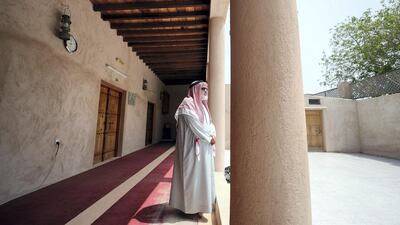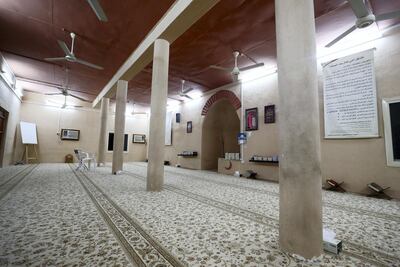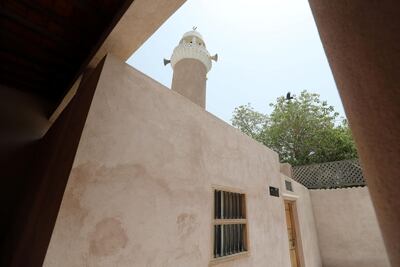Accepting only coffee and handfuls of dates as payment, a group of locals from Khor Khalba, 68 years ago, built what is now one of the oldest mosques in Sharjah.
Zaid Bin Thabit Mosque stands to this day, welcoming worshippers who must first spot the minaret poking out from behind a thicket of trees.
Built with coral and mud pulled from the neighbouring sea and fortified with palm fronds, the 493 square metre mosque was considered one of the largest of its time, big enough to accommodate 150 worshippers praying shoulder-to-shoulder.
“They were not greedy and thinking of money and life. They built it purely for Allah,” says Othman Al Barout, one of the oldest residents of Khor Kalba.
“Builders were given dates and coffee measured by the palm of a middle-sized hand in exchange for the building material and the builders offered their skills in return, this shows how all the community collaborated and offered what they have to build the house of Allah,” the octogenarian says.
Close enough to the Sea of Oman that worshippers could hear waves gently lapping the coast, the mosque is within walking distance of Khorfakkan Heritage Village and its historical fort. Its sand-coloured walls, antique lanterns and ornate wooden double-winged doors blend in perfectly into the snapshot of history.
“I remember praying there with my father. It was a bit different from now, with walls made of mud-bricks, coral stones and a palm-frond roof. It has many windows that helps to cool the Masjid during summer as there were no air-conditions back then,” says Rashid Al Zaabi, 55.
“All the residents of the area, visitors of Khor Kalba and fishermen used to pray in it. We used to call it Masjid Al Qibab due to the dome on its minaret but after that, they called it Zaid Bin Thabit,” he says.
_________________
Read more on the 'Mosques of the UAE':
100-year-old mosque built by pearl diver has stood test of time
Quiet Abu Dhabi community mosque attracts a multinational congregation
Peace of worship found at RAK's Sheikh Salem mosque, where former Ruler prayed
_________________
The mosque was renamed in the 1980s after Zaid ibn Thabit, the personal scribe of Prophet Mohammed, who collated the Quran into a single volume after the Prophet’s death.
It was last renovated in 2014.
“They added air-conditions, built a roof, added an Imam room and renovated the whole place but kept the historical spirit which makes the mosque so special,” says Mr Al Zaabi.
“Fishermen, passers-by and residents of the area still pray in the mosque. It represents the country’s heritage and religion and the efforts of the local residents in building houses for worship and their care of them,” he says.
An Emirati author, who has researched the history of mosques in the eastern region of the country, says that local residents who memorised the Quran would be the ones to call for prayers at the mosque.
“The mosque didn’t have any Imam when it was first built. It was built by the hands of the most skilled builders in that time at the residents own expense,” said Rashid Al Naqbi.
“It’s considered one of the oldest ancient and historical mosques in the Kalba with its unique architectural design, minaret and somehow big courtyard if compared to other mosques back then,” he says.
Mohammed Al Kindi, the Mosques Affairs Officer at Kalba Islamic Affairs department, says the community spirit has not waned over the past 68 years with many residents still offering their help with maintaining the mosque.
“If they find anything that needs to be replaced or fixed they offer their help and either bring someone to fix it or they buy a new one. For example, this week one of the residents voluntarily replaced the damaged water cooler with a new one.”



